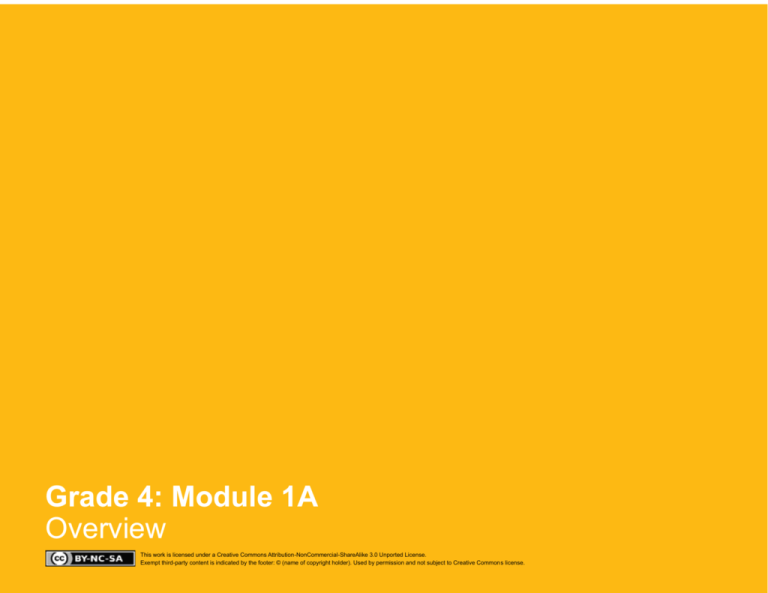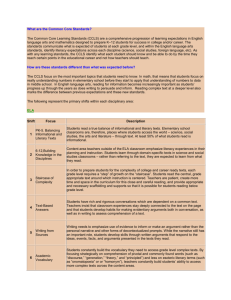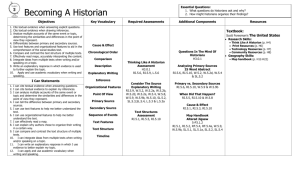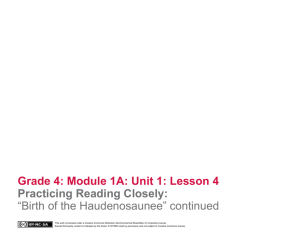
Grade 4: Module 1A
Overview
This work is licensed under a Creative Commons Attribution-NonCommercial-ShareAlike 3.0 Unported License.
Exempt third-party content is indicated by the footer: © (name of copyright holder). Used by permission and not subject to Creative Commons license.
GRADE 4: MODULE 1A: OVERVIEW
Becoming a Close Reader and Writing to Learn:
Oral Tradition, Symbolism, Building Community
Module 1A focuses on building community by making connections between visual
imagery, oral accounts, poetry, and written texts of various cultures, with a focus on
the Haudenosaunee (Iroquois) culture. Students will determine a central idea and
demonstrate how gathering information from a variety of sources can help us
understand a central idea more fully. Module 1 also reinforces reading fluency,
close text analysis, explanatory paragraph writing, and presenting to peers. The
module reinforces the fact that Native Americans—specifically the Iroquois
(Haudenosaunee, People of the Longhouse) —were early inhabitants of the New
York region and state, and continue to contribute to the region’s history.
In Unit 1, students will read and listen closely to interpret main ideas and thematic
connections between visual imagery (symbols and graphics), oral tradition
(Haudenosaunee video), and literary texts (“Birth of the Haudenosaunee”, Two Row
Wampum, and Frost’s “A Time to Talk”). Students will demonstrate their
understanding by creating symbols and writing explanatory paragraphs about how
they connect to the texts (W.4.11, RL.4.11).
In Unit 2, students read The Iroquois: The Six Nations Confederacy and view
authentic video about the Haudenosaunee, to learn about how the community
transcends time. At the end of Unit 2, students write an explanatory piece about
how the lives of the Haudenosaunee people have changed and remained the same
since the Europeans came to the continent, drawing evidence from two sources to
support their claim (W.4.9). Unit 2 will also introduce an optional Independent
Reading project that focuses on character development and connects to the other
module texts.
Unit 3 consists of a read-aloud of Patricia Polacco’s The Keeping Quilt and a close
reading of other texts to draw the module together. Students will use these texts,
and what they have learned about symbols, culture and community, to create a
“quilt” that defines the classroom community. Each student will create a symbol on
a quilt square about themselves in the context of the classroom [how they can
contribute to the classroom community/ what is required of them in order to make
the classroom a peaceful community/ what community means]; write explanatory
paragraphs about their quilt square, including how it was influenced by the module
texts; and present it to the class as the performance task (W.4.2).
Guiding Questions And Big Ideas
• How can we use what we have learned about another community to help define what we want for our classroom community?
• Peace can be created and sustained through agreements and actions.
• Understanding a culture comes from studying stories, oral traditions, and symbols.
Performance Task
Classroom Community Quilt
This performance task gives students a chance to learn about each other and apply the knowledge they have gathered from the module to create a classroom community.
Students will create a “quilt” that defines the classroom community, where each student creates a symbol on a quilt square about themselves [how they can contribute to
the classroom community/ what is required of them in order to make the classroom a peaceful community/ what community means], write explanatory paragraphs
about their quilt square, and present it to the class as the performance task. The three-part performance task centers on NYSP12 ELA Standards W.4.2,
W.4.5, W.4.9, and L.4.3.
© 2014 NYSED, Albany, NY. All Rights Reserved.
NYS Common Core ELA Curriculum • G4:M1A: Overview • June 2014 •
1
GRADE 4: MODULE 1A: OVERVIEW
English Language Arts Outcomes
NYSP12 CCLS Assessed in This Module: READING—LITERATURE
Long-Term Learning Targets
• RL.4.1. Refer to details and examples in a text when explaining what the text
says explicitly and when drawing inferences from the text.
• I can explain what a text says using specific details from the text.
• RL.4.2. Determine a theme of a story, drama, or poem from details in the text.
• I can determine the theme of a story or text.
• RL.4.3. Describe in depth a character, setting, or event in a story or drama,
drawing on specific details in the text (Independent Reading)
• I can describe a story’s character or events using specific details from the
text.
• RL.4.4. Determine the meaning of words and phrases as they are used in a
text.
• I can determine word meanings in a text.
• RL.4.7 Make connections between the text of a story or drama and a visual
or oral presentation of the text, identifying how each version reflects
specific descriptions and directions in the text.
• I can make connections between symbols, images, texts, and oral
presentations.
• RL.4.9 Compare and contrast the treatment of similar themes and topics
and patterns of events in stories, myths, and traditional literature from
different cultures
• I can compare different versions of the same story.
NYSP12 CCLS Assessed in This Module: READING—Informational Text
Long-Term Learning Targets
• RI.4.1. Refer to details and examples in a text when explaining what the text says
explicitly and when drawing inferences from the text.
• I can use details and examples to explain explicit information and inferences in
informational text.
• RI.4.2. Determine the main idea of a text and explain how it is supported by key
details; summarize the text.
• I can determine the main idea using specific details from the text.
• RI.4.3. Explain events, procedures, ideas, or concepts in a historical, scientific,
or technical text, including what happened and why, based on specific
information in the text.
• I can explain the main points in a nonfiction text accurately.
• RI.4.4. Determine the meaning of general academic and domain-specific words
or phrases in a text relevant to a grade 4 topic or subject area.
• I can determine the meaning of academic words or phrases in an informational
text.
© 2014 NYSED, Albany, NY. All Rights Reserved.
• I can determine the meaning of content words or phrases in an informational
NYS Common Core ELA Curriculum • G4:M1A: Overview • July 2014 • 2
text.
• I can make inferences using specific details from the text.
• I can summarize informational or persuasive text.
• I can support my explanation using specific details in the text.
GRADE 4: MODULE 1A: OVERVIEW
English Language Arts Outcomes
NYSP12 CCLS Assessed in This Module: Informational Text
Long-Term Learning Targets
• RI.4.5. Describe the overall structure (e.g., chronology, comparison,
cause/effect, problem/solution) of events, ideas, concepts, or information in a
text or part of a text.
• I can describe the organizational structure in informational or persuasive text
• RI.4.7. Interpret information presented visually, orally, or quantitatively (e.g., in
charts, graphs, diagrams, time lines, animations, or interactive elements on Web
pages).
• I can interpret information presented through charts, graphs, timelines, or
websites.
NYSP12 CCLS Assessed in This Module: Writing
Long-Term Learning Targets
W.4.2. Write informative/explanatory texts to examine a topic and convey ideas
and information clearly.
Introduce a topic clearly and group related information in paragraphs and
sections.
Develop the topic with facts, definitions, concrete details, quotations, or other
information and examples related to the topic.
Link ideas within categories of information using words and phrases (e.g., another,
for example, also, because).
Use precise language and domain-specific vocabulary to inform about or explain
the topic.
Provide a concluding statement or section related to the information or
explanation presented.
I can write an informative/explanatory text.
I can write an informative/explanatory text that has a clear topic.
I can group supporting facts together about a topic in an informative/explanatory
text.
I can develop the topic with facts, definitions, details, and quotations.
I can use linking words and phrases (e.g., another, for example, also, because) to
connect ideas within categories of information.
I can use contextually specific language/vocabulary to inform about or explain a
topic.
I can construct a concluding statement or section of an informative/explanatory
text.
• W.4.5. With guidance and support from peers and adults, develop and
strengthen writing as needed by planning, revising, and editing.
• I can use the writing process to produce clear and coherent writing (with
support).
© 2014 NYSED, Albany, NY. All Rights Reserved.
NYS Common Core ELA Curriculum • G4:M1A: Overview • July 2014 •
3
GRADE 4: MODULE 1A: OVERVIEW
English Language Arts Outcomes
NYSP12 CCLS Assessed in This Module: Writing
Long-Term Learning Targets
• W.4.9. Draw evidence from literary or informational texts to support analysis,
reflection, and research.
• I can choose evidence from fourth-grade literary or informational texts to
support analysis, reflection, and research.
• Apply grade 4 Reading standards to informational texts (e.g., “Explain how an
author uses reasons and evidence to support particular points in a text.).
• I can explain how an author uses reasons and evidence to support particular
points in a text.
• W.4.11 Create and present a poem, narrative, play, artwork or literary view in
response to a particular author or theme studied in class
• I can create artwork and explain how it connects to themes studied in class
NYSP12 CCLS Assessed in This Module: SPEAKING AND LISTENING
Long-Term Learning Targets
• L.4.3. Use knowledge of language and its conventions when writing, speaking,
reading, or listening.
• I can express ideas using carefully chosen words.
• Choose words and phrases to convey ideas precisely.
• L.4.4. Determine or clarify the meaning of unknown and multiple-meaning
words and phrases based on grade 4 reading and content, choosing flexibly from
a range of strategies.
• Use context (e.g., definitions, examples, or restatements in text) as a clue to the
meaning of a word or phrase.
© 2014 NYSED, Albany, NY. All Rights Reserved.
• I can use a variety of strategies to determine the meaning of words and
phrases.
• I can use what the text says to help me to determine what a word or phrase
means.
NYS Common Core ELA Curriculum • G4:M1A: Overview • July 2014 •
4
GRADE 4: MODULE 1A: OVERVIEW
Central Texts
1. “Birth of the Haudenosaunee” By
Dehowӓhdadih - Bradley Powless, Eel Clan, Onondaga Nation–included in module
2. Haudenosaunee Thanksgiving Address (excerpts)- included in module
3. Two Row Wampum – included in module
4. “A Time to Talk” by Robert Frost- included in module
5. Video: “The Stone Canoe”- http://www.onondaganation.org/news/video/2008/the-stone-canoe-the-story-of-the-peace-maker-2/
6. Video: Recording our History link to be added
7. Mary Englar, The Iroquois: The Six Nations Confederacy (Mankato, MN: Capstone Press, 2003); ISBN: 978-0-7368-4817-6
8. Video: “Life at Onondaga”- link to be added
9. The Keeping Quilt by Patricia Polacco (for teacher read aloud; only one copy needed); ISBN: 978-0-6898-4447-8
10. Other open-source texts- included in module
11. Optional Independent Reading (see guidance document): Joseph Bruchac, Eagle Song (New York: Puffin Books, 1997); ISBN: 978-0-14-130169-3
© 2014 NYSED, Albany, NY. All Rights Reserved.
NYS Common Core ELA Curriculum • G4:M1A: Overview • July 2014 •
5
GRADE 4: MODULE 1A: OVERVIEW
Calendared Curriculum Map:
Week at a Glance
Week
Instructional Focus
Long-Term Targets
Assessments
• I can explain what a text says using specific
details from the text.
• Mid-Unit 1 Assessment: Independent
reading about the Haudenosaunee Two Row
Wampum story; make inferences; use
specific details to answer questions about the
text. (RI.4.1, RI.4.3, SL.4.1)
Unit 1: Haudenosaunee: Consensus Building in Community
Weeks 1-3
• Mystery Symbols: Gallery Walk of various
symbols including those of the
Haudenosaunee
• Hear and read historical Haudenosaunee
texts and video
• I can explain the main points in a historical
text accurately.
• Use maps for student reference.
• I can effectively participate in discussion
with my peers and adults.
• Read “Birth of the Haudenosaunee”
• I can explain oral tradition
• View an introduction video from the
Onondaga Nation that addresses oral
tradition
• Read a poem about communication.
• Learn the structure of an explanatory
paragraph.
• Write explanatory paragraphs
© 2014 NYSED, Albany, NY. All Rights Reserved.
• I can write an informative/explanatory text.
• End of Unit 1 Assessment: Write explanatory
paragraph about student-created wampum
belts and how it connects to the texts. (W.4.2
and SL.4.1)
NYS Common Core ELA Curriculum • G4:M1A: Overview • July 2014 •
6
GRADE 4: MODULE 1A: OVERVIEW
Calendared Curriculum Map:
Week at a Glance
Week
Instructional Focus
Long-Term Targets
Assessments
• I can determine the main idea using specific
details from the text.
• Mid-Unit 2 Assessment: Independent
reading regarding Iroquois and answering
text-dependent questions. (RI.4.1, RI.4.2,
W.4.8, W.4.2, SL.4.1)
Unit 2: Haudenosaunee: A Community that Transcends Time
Weeks 3-5
• Read The Iroquois: The Six Nations
Confederacy with a focus on central ideas,
supporting details, and context clues
• View video of Haudenosaunee today
• Read article about contemporary lacrosse
players
• I can determine the meaning of academic
words or phrases in an informational text.
• I can write an informative/explanatory text.
• End of Unit 2 Assessment: Using evidence
from the texts and videos, describe how the
lives of the Haudenosaunee have changed
and stayed the same over time. (RI4.1, RI4.3,
W4.3)
• I can describe a story’s setting using specific
details from text.
• Reading Packet
• Write explanatory paragraphs
Optional
Independent
Reading
Project using
Eagle Song
• Introduce optional Independent Reading
Project.
Write explanatory paragraphs
• I can describe a story’s character using
specific details from text.
• I can determine the theme of a story or text.
• I can effectively participate in a conversation
with my peers and adults
© 2014 NYSED, Albany, NY. All Rights Reserved.
• Students select one scene from Eagle Song
in which the main character displays the
beliefs of the Peacemaker and explain how
the character is upholding traditional values
using details from the texts. (RL.4.3, RL.4.11,
W.4.9)
NYS Common Core ELA Curriculum • G4:M1A: Overview • July 2014 •
7
GRADE 4: MODULE 1A: OVERVIEW
Calendared Curriculum Map:
Week at a Glance
Week
Instructional Focus
Long-Term Targets
Assessments
• Students will listen to a read aloud of
Patricia Polacco’s “The Keeping Quilt”
• I can answer questions using evidence from
the text.
• Mid-Unit 3 : none
• With teacher support, students will close
read and discuss other texts about global
traditions
• I can determine the main idea using specific
details from the text.
Unit 3: Creating A Classroom Community
Week 6 - 7
• I can connect texts from different cultures
around central ideas
• I can effectively participate in discussions
with my peers and adults.
• Students will create a symbol that represents
themselves on a “quilt square”
• Students will write a paragraph to explain
their symbol
• Students will present their paragraph to the
class
• The class will build the quilt, react to it
individually, and engage in a class discussion
about what the quilt means and says about
their community
• The students will connect aspects of their
community (based on the quilt) to texts,
visuals, and or videos they have studied in
the units
© 2014 NYSED, Albany, NY. All Rights Reserved.
• I can write an informative/explanatory text.
• End of Unit 3/Final Performance Task:
• I can express my ideas using carefully chosen
words and symbols.
• Students will use these texts, and what they
have learned about symbols and community
to create a “quilt” that defines the classroom
community, where each student creates a
symbol on a quilt square about themselves in
the context of the classroom [how they can
contribute to the classroom community/
what is required of them in order to make
the classroom a peaceful community/ what
community means], writes explanatory
paragraphs about their quilt square, and
presents it to the class. They will then link
the message of their classroom quilt to texts,
visuals, or videos they have studied in this
module. (RL4.11, RI4.9, SL4.4, W4.2)
• I can use the writing process to produce clear
and coherent writing.
• I can effectively present to my peers
• I can participate in discussions with my
peers and adults.
• I can make connections between texts,
visuals, and oral presentations.
NYS Common Core ELA Curriculum • G4:M1A: Overview • July 2014 •
8









